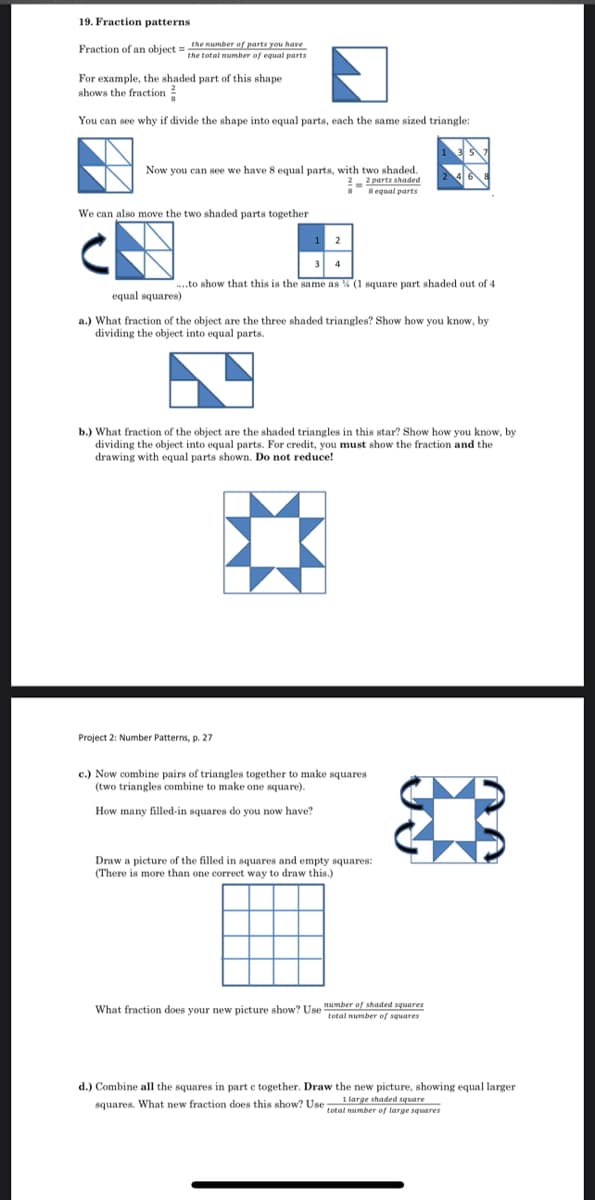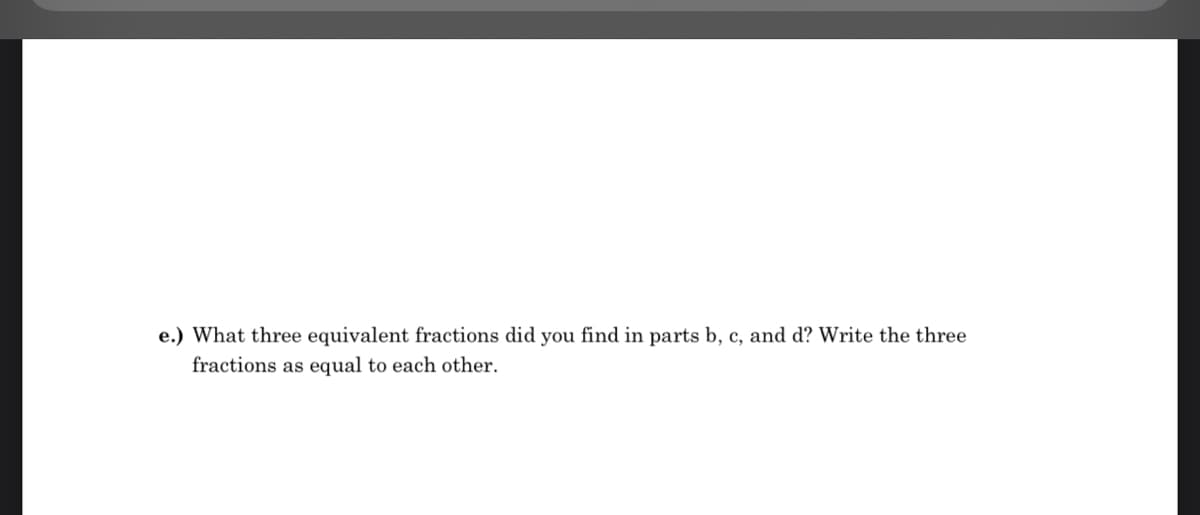19. Fraction patterns the number of parts you hare Fraction of an object the tatal umber of equal parts For example, the shaded part of this shape shows the fraction You can see why if divide the shape into equal parts, each the same sized triangle: Now you can see we have 8 equal parts, with two shaded. parts shaded Bequal parts We can also move the two shaded parts together ..to show that this is the same as (1 square part shaded out of 4 equal squares) a.) What fraction of the object are the three shaded triangles? Show how you know, by dividing the object into equal parts. b.) What fraction of the object are the shaded triangles in this star? Show how you know, by dividing the object into equal parts. For credit, you must show the fraction and the drawing with equal parts shown. Do not reduce! Project 2: Number Patterns, p. 27 c.) Now combine pairs of triangles together to make squares (two triangles combine to make one square). How many filled-in squares do you now have? Draw a picture of the filled in squares and empty squares: (There is more than one correct way to draw this.) What fraction does your new picture ahow? Uee mber of shaded squares tetal umber of squares d.) Combine all the squares in part e together. Draw the new picture, showing equal larger ouares What new fraction does this show? Use tal umber of large squares 1 large shaded square
19. Fraction patterns the number of parts you hare Fraction of an object the tatal umber of equal parts For example, the shaded part of this shape shows the fraction You can see why if divide the shape into equal parts, each the same sized triangle: Now you can see we have 8 equal parts, with two shaded. parts shaded Bequal parts We can also move the two shaded parts together ..to show that this is the same as (1 square part shaded out of 4 equal squares) a.) What fraction of the object are the three shaded triangles? Show how you know, by dividing the object into equal parts. b.) What fraction of the object are the shaded triangles in this star? Show how you know, by dividing the object into equal parts. For credit, you must show the fraction and the drawing with equal parts shown. Do not reduce! Project 2: Number Patterns, p. 27 c.) Now combine pairs of triangles together to make squares (two triangles combine to make one square). How many filled-in squares do you now have? Draw a picture of the filled in squares and empty squares: (There is more than one correct way to draw this.) What fraction does your new picture ahow? Uee mber of shaded squares tetal umber of squares d.) Combine all the squares in part e together. Draw the new picture, showing equal larger ouares What new fraction does this show? Use tal umber of large squares 1 large shaded square
Big Ideas Math A Bridge To Success Algebra 1: Student Edition 2015
1st Edition
ISBN:9781680331141
Author:HOUGHTON MIFFLIN HARCOURT
Publisher:HOUGHTON MIFFLIN HARCOURT
Chapter6: Exponential Functions And Sequences
Section6.1: Properties Of Exponents
Problem 68E
Related questions
Question

Transcribed Image Text:19. Fraction patterns
Fraction of an object =e number of parts you have
the total number of equal parts
For example, the shaded part of this shape
shows the fraction
You can see why if divide the shape into equal parts, each the same sized triangle:
Now you can see we have 8 equal parts, with two shaded.
2 2 parts shaded
sequal parts
We can also move the two shaded parts together
1 2
3
..to show that this is the same as % (1 square part shaded out of 4
equal squares)
a.) What fraction of the object are the three shaded triangles? Show how you know, by
dividing the object into equal parts.
b.) What fraction of the object are the shaded triangles in this star? Show how you know, by
dividing the object into equal parts. For credit, you must show the fraction and the
drawing with equal parts shown. Do not reduce!
Project
Number Patterns, p. 27
c.) Now combine pairs of triangles together to make squares
(two triangles combine to make one square).
How many filled-in squares do you now have?
Draw a picture of the filled in squares and empty squares:
(There is more than one correct way to draw this.)
What fraction does your new picture show? Use umber of shaded squares
total number of squares
d.) Combine all the squares in part e together. Draw the new picture, showing equal larger
squares. What new fraction does this show? Use total number of large squares
1 large shaded square

Transcribed Image Text:e.) What three equivalent fractions did you find in parts b, c, and d? Write the three
fractions as equal to each other.
Expert Solution
This question has been solved!
Explore an expertly crafted, step-by-step solution for a thorough understanding of key concepts.
This is a popular solution!
Trending now
This is a popular solution!
Step by step
Solved in 5 steps with 6 images

Knowledge Booster
Learn more about
Need a deep-dive on the concept behind this application? Look no further. Learn more about this topic, algebra and related others by exploring similar questions and additional content below.Recommended textbooks for you

Big Ideas Math A Bridge To Success Algebra 1: Stu…
Algebra
ISBN:
9781680331141
Author:
HOUGHTON MIFFLIN HARCOURT
Publisher:
Houghton Mifflin Harcourt

Holt Mcdougal Larson Pre-algebra: Student Edition…
Algebra
ISBN:
9780547587776
Author:
HOLT MCDOUGAL
Publisher:
HOLT MCDOUGAL

Glencoe Algebra 1, Student Edition, 9780079039897…
Algebra
ISBN:
9780079039897
Author:
Carter
Publisher:
McGraw Hill

Big Ideas Math A Bridge To Success Algebra 1: Stu…
Algebra
ISBN:
9781680331141
Author:
HOUGHTON MIFFLIN HARCOURT
Publisher:
Houghton Mifflin Harcourt

Holt Mcdougal Larson Pre-algebra: Student Edition…
Algebra
ISBN:
9780547587776
Author:
HOLT MCDOUGAL
Publisher:
HOLT MCDOUGAL

Glencoe Algebra 1, Student Edition, 9780079039897…
Algebra
ISBN:
9780079039897
Author:
Carter
Publisher:
McGraw Hill


College Algebra (MindTap Course List)
Algebra
ISBN:
9781305652231
Author:
R. David Gustafson, Jeff Hughes
Publisher:
Cengage Learning

Algebra: Structure And Method, Book 1
Algebra
ISBN:
9780395977224
Author:
Richard G. Brown, Mary P. Dolciani, Robert H. Sorgenfrey, William L. Cole
Publisher:
McDougal Littell